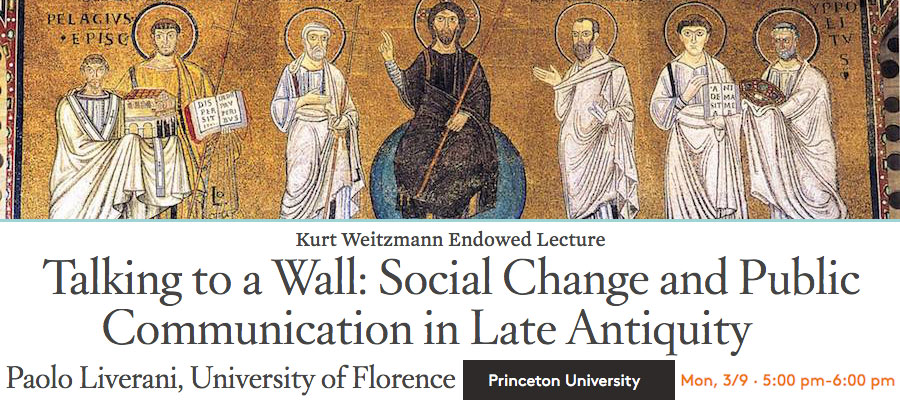Talking to a Wall: Social Change and Public Communication in Late Antiquity, Kurt Weitzmann Endowed Lecture by Paolo Liverani (University of Florence), Princeton University, March 9, 2020, 5:00–6:30 pm
In Classical Antiquity images and inscriptions have always addressed the beholder, mostly in the funerary context. The deceased addresses the passerby telling him his story or, vice versa, the passerby addresses the deceased with formulae such as “may the earth rest lightly on you”. Late Antiquity developed two new phenomena: a more generalized use of frontality in the figurative art, and the use of the first and second person singular in public inscriptions.
Standing before a frontal image, one has the impression that it is watching us, questioning us, looking for a sort of dialogue with us. In several cases, this effect is reinforced and more clearly expressed by an inscription addressing the viewer. What is new is the character of the monument, no longer confined to the private space of a family tomb chamber, but aimed at the wider community of citizens in the public spaces and monuments of the city, or at the Christian congregation in the basilicas erected for the cult of God with sumptuous mosaics accompanied by verse inscriptions.
In this talk, I shall argue that in Late Antiquity, the beholder is no longer a single, passive recipient of a message directed at him. Rather, he develops a more complex identity as he is caught up by the enunciational device, as he is directly addressed and then dialogues with the image, or at least is faced with the dialogue between the characters on the figural stage. This new condition derives from the transformation of society, the new relationship between rulers andsubjects and, ultimately, between worshippers and the divine. Inscriptions and the images can be considered an expression in stone of the “acclaimative habit”.
Paolo Liverani is Professor for Topography of Ancient Italy at the University of Florence.
The Kurt Weitzmann Memorial Lecture Series in Late Antique, Early Christian, Byzantine, and Early Medieval Art was endowed by a bequest from the estate of Professor Kurt Weitzmann and Josepha Weitzmann-Fiedler.
